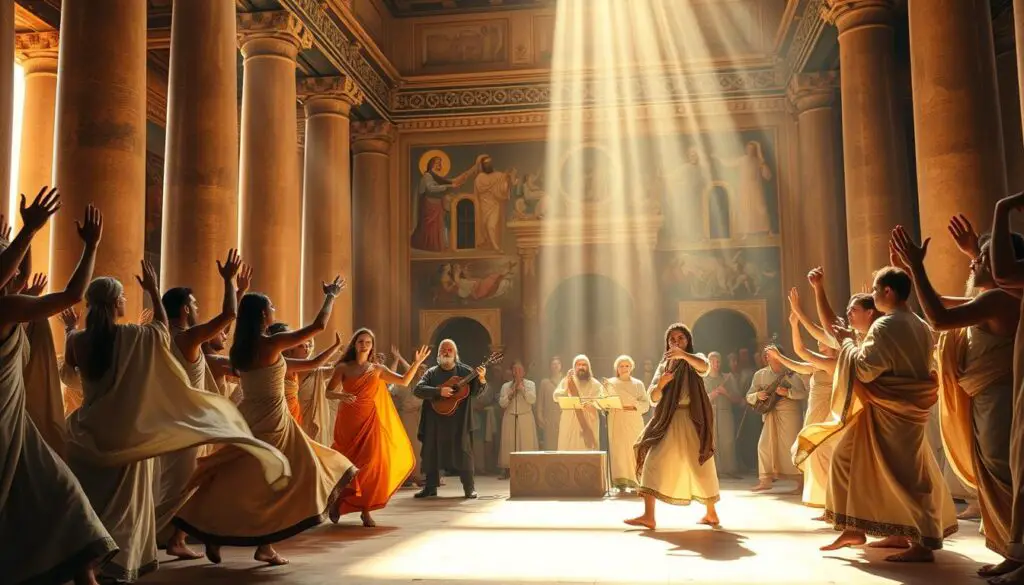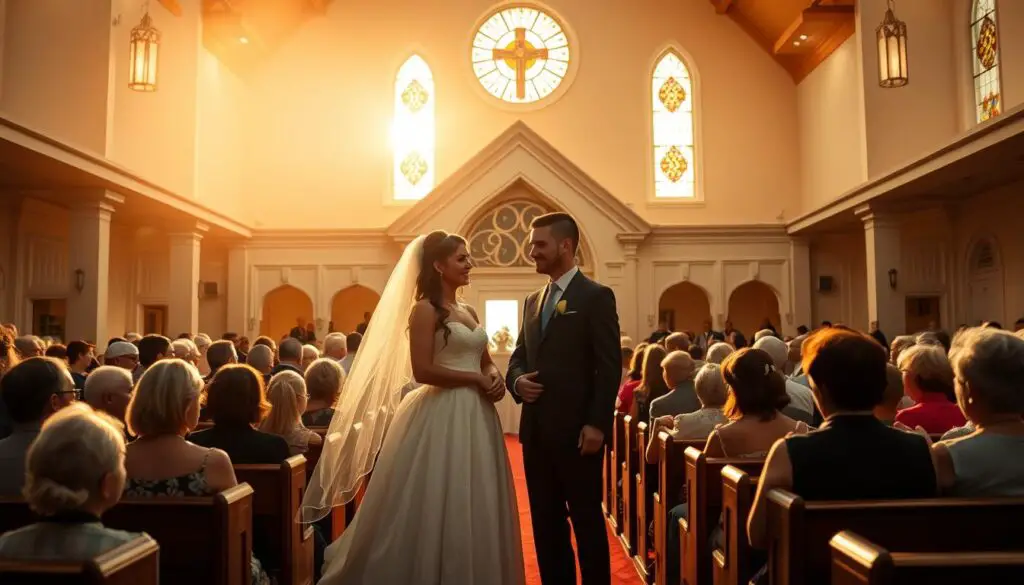How do faith traditions approach movement as worship? This question sparks lively debates within many congregations. For some, dance holds deep spiritual meaning. Others see it as a distraction from solemn rituals. Let’s explore how one denomination navigates this topic.
Historical roots shape modern practices. Early leaders often emphasized modesty and restraint, influencing worship styles. Yet cultural shifts have introduced new perspectives. Global communities now blend local customs with shared beliefs.
Events like international conferences highlight these evolving views. Attendees share stories of joyful celebrations and cautious guidelines. From Brazil to Nigeria, interpretations vary while core values remain.
Key Takeaways
- Views on dance range from cautious to celebratory across congregations
- Historical teachings emphasize modesty in worship practices
- Cultural context significantly impacts modern interpretations
- Global gatherings showcase diverse approaches to movement
- Some communities integrate dance into youth programs cautiously
- Debates continue about appropriate expressions of faith
Introduction to the Baptist Perspective on Dancing
Movement in worship spaces often sparks spirited conversations. Among Southern Baptist communities, these discussions reveal a fascinating blend of tradition and cultural adaptation. While some congregations maintain cautious stances, others celebrate movement as part of their spiritual identity.
Setting the Stage for Discussion
Early teachings from the Southern Baptist Convention emphasized modesty in worship. This created guidelines that discouraged expressive practices. However, modern congregations increasingly balance these roots with local customs.
Nora O. Lozano notes:
“Tensions arise when global traditions meet doctrinal frameworks. Yet these moments also foster creative expressions of faith.”
The Cultural and Spiritual Significance
International gatherings showcase this diversity. At a recent conference in Brazil, attendees shared videos of celebratory processions. Nigerian worship services often blend traditional dances with hymns.
| Traditional View | Modern Approach | Cultural Influence |
|---|---|---|
| Limited movement | Choreographed worship | Local festivals |
| Focus on scripture | Youth dance ministries | Global exchanges |
| Modesty guidelines | Adaptive celebrations | Community identity |
Generational differences further shape opinions. Older members often prefer classical hymns, while younger groups experiment with movement-based programs. These shifts reflect broader debates about tradition’s role in evolving societies.
Historical Background and Biblical Context
Ancient scriptures and denominational shifts reveal surprising insights about movement in sacred spaces. While some faith groups embraced rhythmic expression, others saw potential for distraction.

Biblical References and Early Teachings
Scriptures like Exodus 15:20 show Miriam leading celebratory dances after crossing the Red Sea. King David’s unrestrained worship in 2 Samuel 6:14 demonstrates movement as spiritual joy. Yet early Baptist leaders focused on Paul’s call for “decency and order” (1 Corinthians 14:40).
Missionaries in the 1800s often discouraged local dance customs during outreach. As historian Margaret Bendroth notes:
“Fear of appearing too Catholic or Pentecostal shaped many early restrictions on movement in worship.”
Evolution of Traditions Over Time
Twentieth-century debates intensified as churches balanced scripture with cultural changes. The Baptist Convention’s 1963 statement cautioned against social dancing while allowing modest expressions in worship services.
| Biblical Era | Early Teachings | Modern Practice |
|---|---|---|
| Exodus celebrations | Strict modesty rules | Youth choreography |
| Davidic worship | Anti-Catholic bias | Adaptive liturgies |
| Psalms 149:3 | Missionary influences | Global hybrid forms |
Today’s congregations reflect this layered history. Some integrate liturgical dance during holidays, while others maintain simpler hymn-based services. These choices often depend on a church’s geographic roots and generational makeup.
can baptist religion dance: A Closer Look
Worship traditions reveal fascinating diversity among congregations sharing common roots. While some groups maintain strict guidelines, others reinterpret historical teachings through modern lenses. This spectrum of practice reflects both doctrinal priorities and community identity.
Denominational Differences in Practice
Conservative congregations often reference Paul’s teachings about orderliness in worship spaces. A pastor from Texas explains:
“We avoid anything distracting from scripture – that includes rhythmic movement during services.”
Meanwhile, progressive communities highlight David’s exuberant biblical worship as justification for choreographed elements.
Urban churches frequently blend cultural influences into their services. Atlanta’s Grace Fellowship incorporates step routines during youth events, while rural Midwestern assemblies maintain hymn-only traditions. These choices often reflect leadership perspectives on scriptural interpretation.
Impact of Cultural Shifts and Global Influences
International communities demonstrate how local customs reshape worship styles:
| Region | Practice | Influence Source |
|---|---|---|
| Nigeria | Processional dances | Traditional festivals |
| Brazil | Carnival-inspired moves | Community celebrations |
| Philippines | Bamboo pole routines | Indigenous heritage |
Social gatherings reveal another layer of complexity. Many congregations permit line dancing at weddings yet prohibit similar movements during Sunday services. This distinction between celebratory and sacred spaces continues to evolve through cross-cultural exchanges.
Digital connectivity accelerates these changes. Viral worship videos from Nairobi to Nashville inspire new conversations about appropriate expressions of faith. Younger members increasingly seek joyful physicality in spiritual practices, challenging older generations’ preferences.
Contemporary Interpretations and Modern Worship
Technology reshapes spiritual expressions in unexpected ways. Recent gatherings like the CBF General Assembly revealed fresh approaches to movement in sacred spaces. Leaders now wrestle with balancing tradition and innovation.
Current Debates Among Congregations
Some communities embrace rhythmic elements during services, while others maintain reservations. “Movement opens a window to heartfelt praise,” argues Pastor Leah Martinez of Houston. Critics counter that physical expressions might overshadow scriptural focus.
Digital and In-Person Worship Experiences
Livestreamed services create new opportunities for creative expression. Churches experimenting with multimedia often blend choreographed sequences into online broadcasts. This digital shift fosters cross-cultural idea exchanges through shared videos and virtual conferences.
| Platform | Innovation | Challenge |
|---|---|---|
| Live Streams | Interactive prayer motions | Technical limitations |
| Social Media | Global dance collaborations | Tradition preservation |
| Hybrid Services | Augmented reality elements | Generational preferences |
Young adults increasingly seek worship styles reflecting their multicultural experiences. Urban congregations often lead this shift, blending global music traditions with local movement practices. These developments continue to spark passionate discussions about faith expression in changing times.
The Role of Social and Liturgical Dancing in the Baptist Community
Celebratory moments often reveal how traditions adapt to modern life. While worship services maintain specific guidelines, social gatherings showcase a different side of cultural expression. Many families blend faith with joyful movement during milestone events, creating memorable experiences rooted in community values.

Movement in Milestone Celebrations
Weddings highlight this balance beautifully. A recent Texas reception featured line dancing to country hymns, while the ceremony itself avoided rhythmic elements. “We celebrate love through both reverence and joy,” explained the bride’s mother. Such events reflect how some groups separate sacred rituals from festive traditions.
Smaller congregations often lead innovative approaches. At an Oklahoma family reunion, grandparents shared stories of square dancing at harvest festivals. Younger members now organize choreographed flash mobs for anniversary parties. These shifts show evolving attitudes toward physical expression in social settings.
| Traditional Approach | Modern Adaptation | Event Type |
|---|---|---|
| No partnered dances | Group line dances | Wedding receptions |
| Hymns-only policy | Blended playlists | Youth gatherings |
| Separate gender activities | Mixed-group routines | Community festivals |
Regional differences further shape practices. Coastal communities frequently incorporate beachside shag dancing into vow renewals, while Midwestern groups prefer potluck dinners with minimal movement. These choices often depend on local leadership and generational preferences.
Current trends mirror broader cultural shifts. As one event planner noted: “Families want celebrations that honor their roots while feeling relevant today.” This duality ensures lively debates – and creative solutions – within the denomination for years to come.
External Influences and Global Baptist Practices
Cultural geography shapes worship styles as much as theology does. Across continents, communities adapt traditions to reflect local values while maintaining core beliefs. This dynamic creates fascinating contrasts between groups sharing similar doctrinal roots.
Regional Preferences in Spiritual Expression
The Southern Baptist Convention historically viewed rhythmic movement as a potential distraction during services. Many congregations still follow guidelines limiting physical expressions. Meanwhile, Brazilian Baptists often incorporate samba-inspired steps into Easter processions, blending faith with cultural heritage.
Rev. Emmanuel Adebayo from Lagos explains:
“Our Sunday services include traditional Yoruba dance patterns – it’s how we connect generations to scripture.”
| Group | Practice | Cultural Driver |
|---|---|---|
| Southern Baptists | Limited movement | Historical modesty norms |
| Kenyan Baptists | Choreographed hymns | Communal storytelling |
| Korean Baptists | Praise flag routines | Festival traditions |
Urbanization accelerates these differences. Megachurches in Manila host flash mob-style worship events, while Appalachian communities preserve hymn-singing without instrumentation. These choices often spark family discussions about preserving identity versus embracing change.
Perceptions of appropriate movement range widely. Some see spontaneous swaying as joyful celebration, others as risky emotionalism. This issue reveals deeper questions about how communities define reverence in evolving societies.
Conclusion
Faith communities continually wrestle with balancing tradition and cultural relevance. Historical roots emphasizing modesty now meet modern expressions of joy through movement. Believers worldwide navigate these questions while honoring shared values.
The debate centers less on specific actions than on interpreting spiritual principles. Cultural contexts reshape worship styles, from hymn-focused services to vibrant music events. What remains constant is the pursuit of meaningful connection through things that unite.
At its core, this discussion highlights transformative teachings about compassion. Diverse practices—whether through quiet reflection or celebratory events—aim to reflect kindness in action. Styles vary across congregations, but the mission stays rooted in service.
Readers might ask: How do my local traditions click with broader faith principles? Exploring these questions invites deeper understanding. By focusing on shared goals, believers strengthen bonds across generations.
Let your spiritual practices spark curiosity, not conflict. Whether through music, community projects, or collaborative events, embodying love matters most. How might your style of worship grow while staying true to essential truths?
FAQ
How do Baptist traditions view social dancing?
Views vary across congregations. Some emphasize modesty and caution, while others embrace it in celebratory settings like weddings. The Southern Baptist Convention historically discouraged it, but cultural shifts have influenced modern practices.
Is liturgical dance allowed in worship services?
Certain progressive congregations incorporate liturgical dance as a form of spiritual expression. However, many traditional groups avoid it, prioritizing simpler worship styles rooted in scripture.
Do global Baptist communities differ in their approach to dance?
Yes! International groups often blend local cultural traditions with faith. For example, African or Latin American congregations might include rhythmic movement in celebrations, reflecting their heritage.
What role does music play in Baptist worship experiences?
Music is central, with hymns and gospel songs fostering connection. While instruments like pianos or guitars are common, dance isn’t universally integrated—though some youth ministries use upbeat styles for engagement.
Are there guidelines for dancing at family events?
Many believers focus on maintaining reverence. For instance, wedding receptions might feature controlled group dances, but individual congregations often set their own standards based on shared values.
How has the Southern Baptist Convention addressed this topic?
The SBC has historically emphasized scripture-based caution. However, newer generations and multicultural influences have sparked debates about adapting practices while preserving core beliefs.